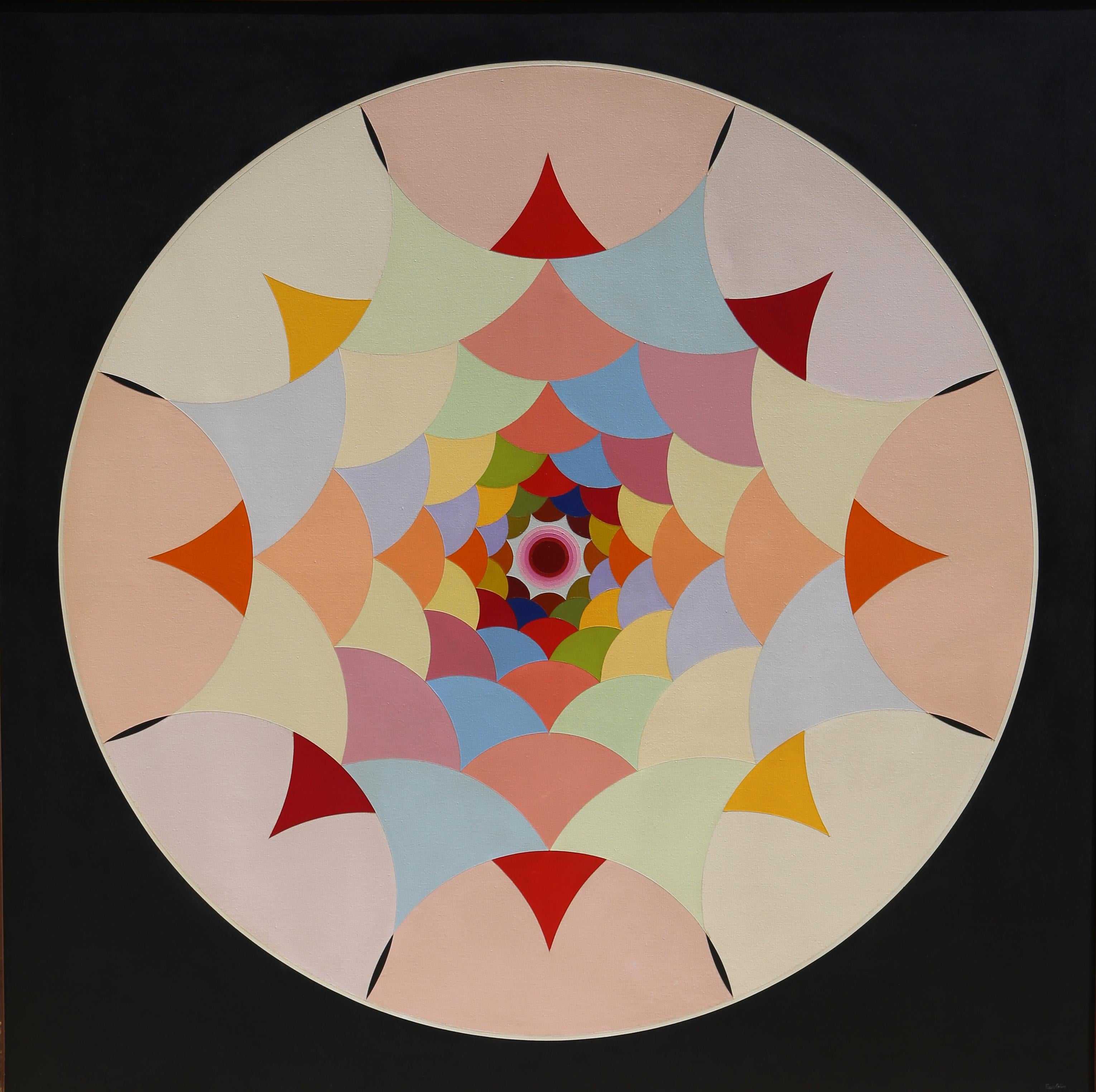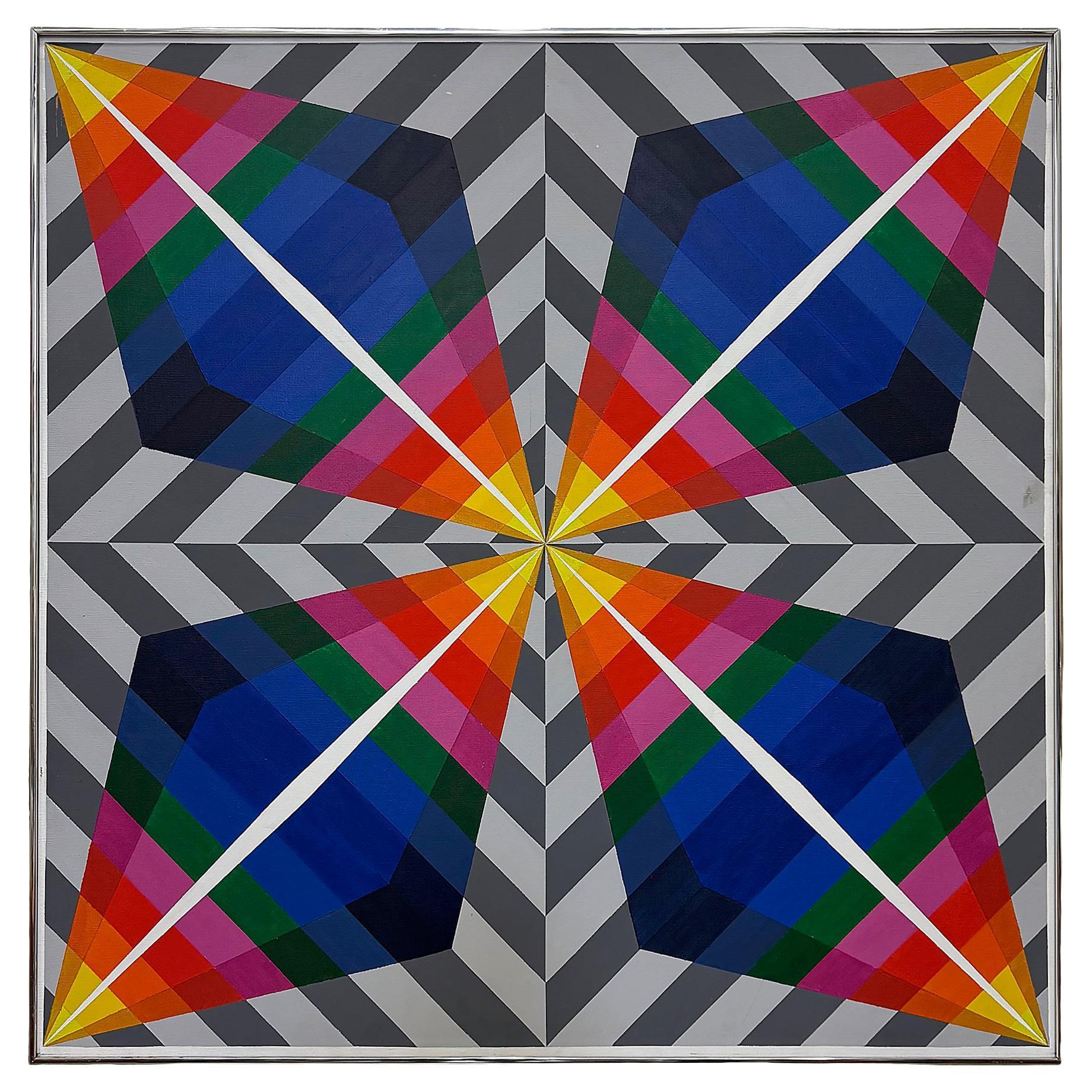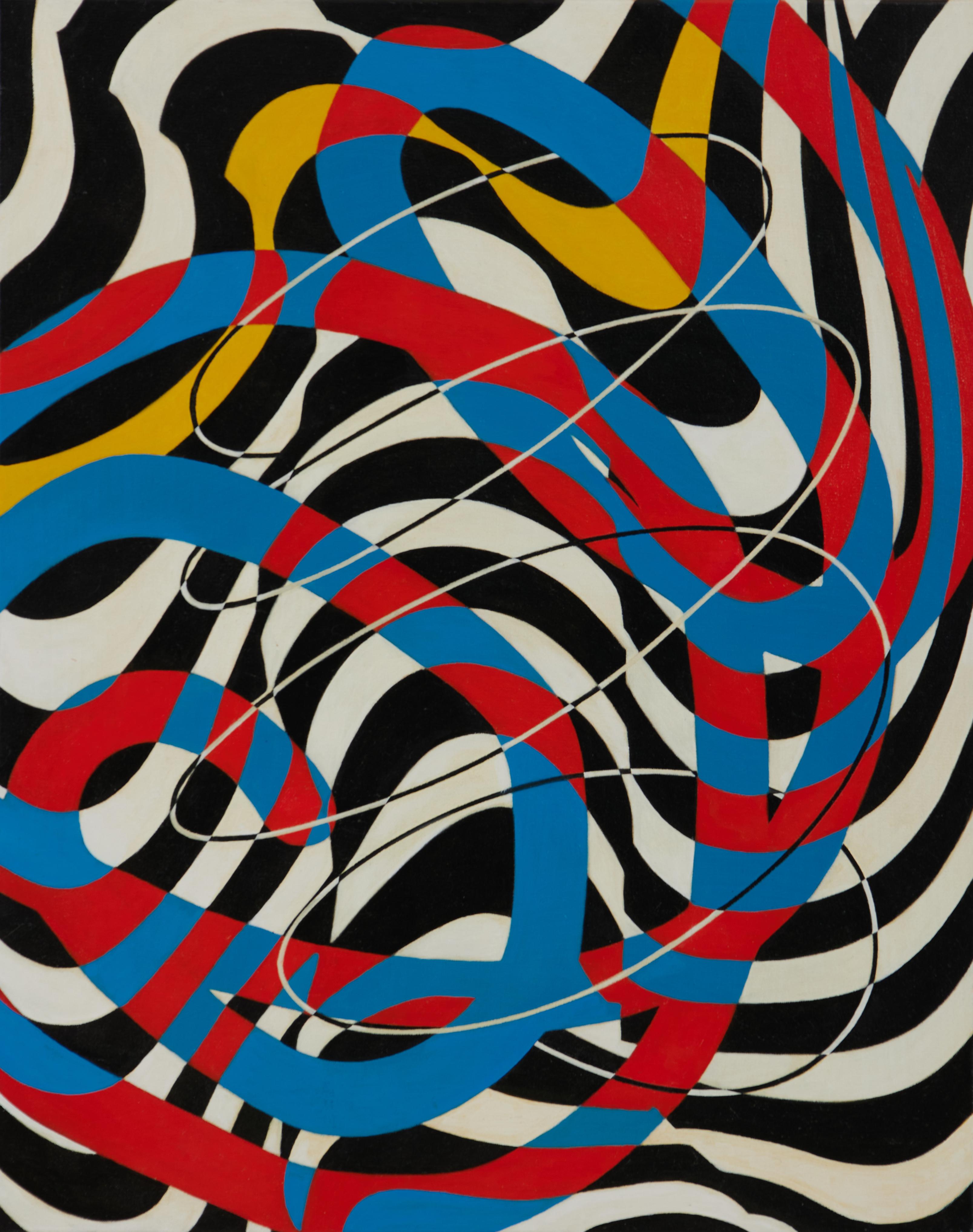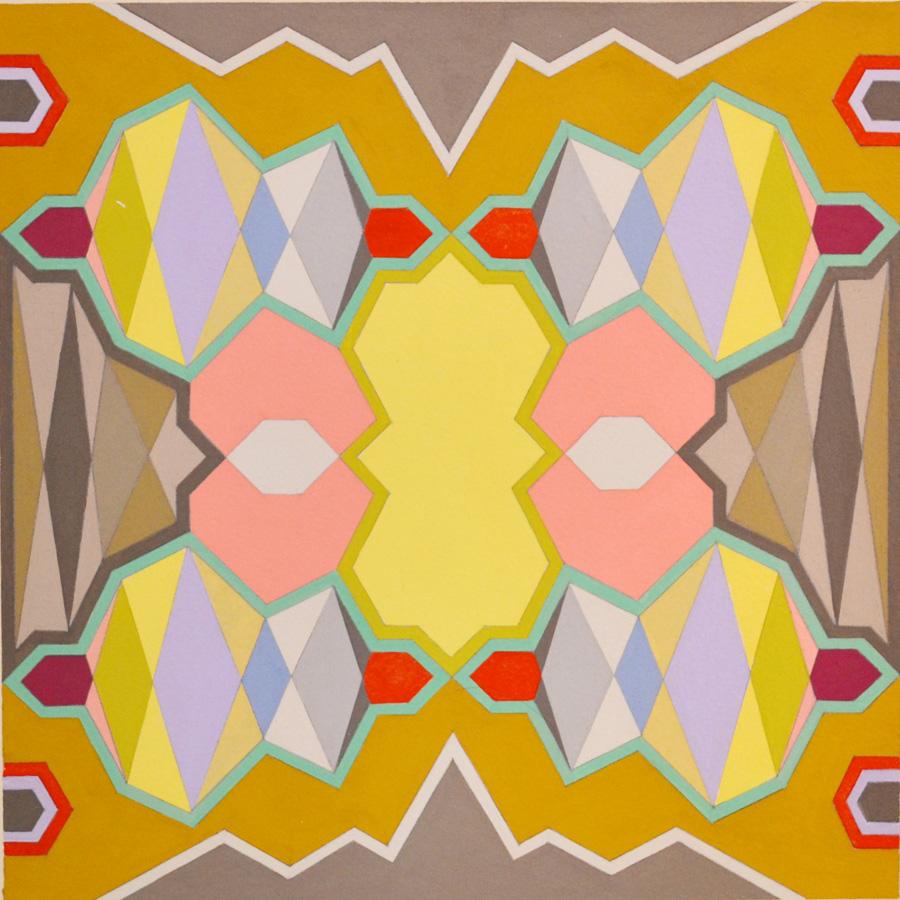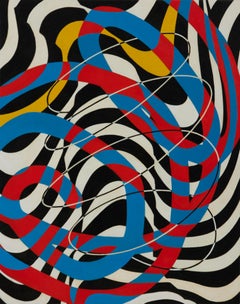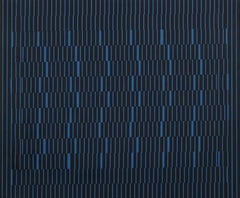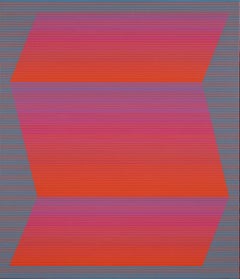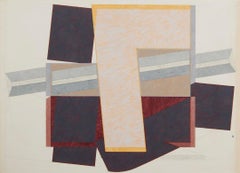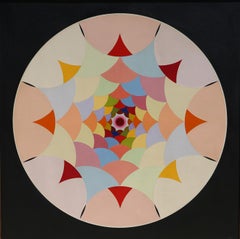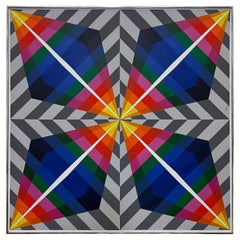Items Similar to Curved Dimensions, Abstract OpArt Geometrical, Mid-Century Cleveland Artist
Want more images or videos?
Request additional images or videos from the seller
1 of 10
Edwin MieczkowskiCurved Dimensions, Abstract OpArt Geometrical, Mid-Century Cleveland Artist1965
1965
$11,000
£8,356.30
€9,625.12
CA$15,736.61
A$17,258.88
CHF 8,901.13
MX$206,171.99
NOK 112,893.40
SEK 105,906.81
DKK 71,906.74
About the Item
Edwin Mieczkowski (American, 1929-2017)
Curved Dimensions, 1965
Acrylic on board
Signed, dated and titled verso
30 x 29.75 inches
Edwin Mieczkowski, born in Pittsburgh, was a leader of geometric and perceptual abstraction during the latter part of the 20th century. Mieczkowski's work first came to prominence in "The Responsive Eye" exhibition, the nation's first major exhibition of perceptual art, held at the Museum of Modern Art in New York in 1965.
Mieczkowski was also featured in the 1964 article in Timemagazine that first used the term "Op Art" to describe paintings that manipulated visual cues in order to reorder and excite viewers' perceptual responses.
With a complex aesthetic that over time has transcended mere tricks of optical art, Mieczkowski has spent nearly four decades producing geometrically paintings, drawings and sculptures, a genre of modern art that is known broadly as perceptual abstraction.
His output of static and dynamic forms create a body of work, still largely intact, that uses visually disorienting, meticulously arranged lines, dazzling kaleidoscopic colors, and alluring juxtapositions of hue and tone, to playfully and seductively present new challenges for the viewer's eyes. The desired result is an optical effect of perpetual motion, harmonics and rhythm. . . .
Along with Frank Hewitt and Ernst Benkert, Mieczkowski was a co-founder in 1959 of the Anonima* group that worked together in Cleveland and New York and declared itself free from the pressures of the art market and the pursuit of personal fame. Members of Anonima often left their works unsigned and vowed to shun the usual art market venues such as commercial galleries, biennials and competitions. Instead, they engaged in a rigorous, self-imposed program of painting exercises to explore the effects of geometry and color on visual perception.
Although Mieczkowski's work hung side-by-side in the MOMA "Responsive Eye" exhibition with such colleagues as Josef Albers, Victor Vasarely, Richard Anuszkiewicz, Morris Louis, Kenneth Noland, Carlos Cruz-Diaz, Ad Reinhardt and Bridget Riley, all of whom went on to considerable fame and fortune, Mieczkowski chose to eschew commercial exhibition and career promotion. Instead, he spent 39 years teaching at the Cleveland Institute of Art and quietly executing a number of public art commissions while independently pursuing his own intuitive explorations in geometric abstraction.
Mieczkowski pursued virtually no commercial sales of his work. Consequently, the body of work he left behind consists of hundreds of paintings, drawings and sculptures only recently viewed by the public.
Throughout his entire career, which he has continued from his studio in California, Mieczkowski has done artwork in evolving styles and mediums, which actively embrace of the logic and rationality of science and technology central to the era of which he was a part. Some of his most lyrical abstractions are inspired by cutting-edge science and, in particular, biomedicine, biotechnology and genetic research. During the more expressly geometric phases of his career, he was described as having "embraced the ruler and the compass as proper and delicate tools to be employed in the name of art." . . . A testament to the notion that vision does not take place automatically as though the revealing of a scene through a window but must be inferred from visual cues, Mieczkowski's oeuvre can be thought of as a precursor of aspects of post-modernism.
In 2004, Mieczkowski's entire life's oeuvre came close to being destroyed as he lay in a hospital bed recovering from heart surgery. Mieczkowski had been in the process of planning his relocation from Cleveland to Huntington Beach, California, when he was rushed to Houston for surgery. He had already sold his studio building but had not yet removed his art; and as he lay in Houston recovering from his second aortic aneurysm, the new owners of the building scheduled it for demolition despite its being filled with Mieczkowski's life work. Friends and art patrons literally rescued the art works, removing them from the building the night before it was to be demolished.
Mieczkowski received his BFA from the Cleveland Institute of Art in 1957 and his MFA from Carnegie Mellon in 1959.
Museums with Mieczkowski's work in their collections include the Museum of Contemporary Art in Lodz, Poland; the Tel Aviv Museum of Modern Art in Israel; the Louisiana Museum of Modern Art in Denmark; the Cleveland Museum of Art; the Akron Art Museum; and the New Jersey State Museum in Trenton. His most prominent public art commissions are in the Cleveland Public Library and the Health Sciences Library of Case Western Reserve University.
- Creator:Edwin Mieczkowski (1929, American)
- Creation Year:1965
- Dimensions:Height: 30 in (76.2 cm)Width: 29.75 in (75.57 cm)
- Medium:
- Movement & Style:
- Period:
- Condition:
- Gallery Location:Beachwood, OH
- Reference Number:1stDibs: LU1768217078882
About the Seller
5.0
Platinum Seller
Premium sellers with a 4.7+ rating and 24-hour response times
Established in 1975
1stDibs seller since 2022
39 sales on 1stDibs
Typical response time: <1 hour
- ShippingRetrieving quote...Shipping from: Beachwood, OH
- Return Policy
Authenticity Guarantee
In the unlikely event there’s an issue with an item’s authenticity, contact us within 1 year for a full refund. DetailsMoney-Back Guarantee
If your item is not as described, is damaged in transit, or does not arrive, contact us within 7 days for a full refund. Details24-Hour Cancellation
You have a 24-hour grace period in which to reconsider your purchase, with no questions asked.Vetted Professional Sellers
Our world-class sellers must adhere to strict standards for service and quality, maintaining the integrity of our listings.Price-Match Guarantee
If you find that a seller listed the same item for a lower price elsewhere, we’ll match it.Trusted Global Delivery
Our best-in-class carrier network provides specialized shipping options worldwide, including custom delivery.More From This Seller
View AllColorful Abstract Geometrical Late 20th Century Painting by Ohio Artist
Located in Beachwood, OH
James Massena March (American, 1953-2021)
Untitled
Oil on canvas
30 x 24 inches
"My paintings are about space, form and energy. I generally start ...
Category
Late 20th Century Abstract Abstract Paintings
Materials
Oil
Double Focus II Mid-Century OpArt Abstract Geometric painting, Cleveland school
By Julian Stanczak
Located in Beachwood, OH
Julian Stanczak (American, 1928-2017)
Double Focus II, 1963
acrylic on canvas
signed and dated verso
33 x 40 inches
Julian Stanczak (American, b. November 5, 1928) was an American ...
Category
1960s Op Art Abstract Paintings
Materials
Acrylic
Twist & the Rain Mid-Century OpArt Geometric Painting by Cleveland School artist
By Julian Stanczak
Located in Beachwood, OH
Julian Stanczak (American, 1928-2017)
Twist and the Rain, 1975
acrylic on canvas
signed verso
30 x 24 inches
Julian Stanczak (American, b. November 5, 1928) was an American painter...
Category
1970s Op Art Abstract Paintings
Materials
Acrylic
Broken Ice, Large Mid-20th Century Gouache, Op Art Cleveland School Artist
By Edwin Mieczkowski
Located in Beachwood, OH
Edwin Mieczkowski (American, 1929-2017)
Broken Ice, 1976
Gouache and pencil on paper
Signed, dated (Feb. 2, 1976) and titled lower right
27.5 x 37.75 inches
35 x 45 inches, framed
Edwin Mieczkowski, born in Pittsburgh, was a leader of geometric and perceptual abstraction during the latter part of the 20th century. Mieczkowski's work first came to prominence in "The Responsive Eye" exhibition, the nation's first major exhibition of perceptual art, held at the Museum of Modern Art in New York in 1965.
Mieczkowski was also featured in the 1964 article in Timemagazine that first used the term "Op Art" to describe paintings that manipulated visual cues in order to reorder and excite viewers' perceptual responses.
With a complex aesthetic that over time has transcended mere tricks of optical art, Mieczkowski has spent nearly four decades producing geometrically paintings, drawings and sculptures, a genre of modern art that is known broadly as perceptual abstraction.
His output of static and dynamic forms create a body of work, still largely intact, that uses visually disorienting, meticulously arranged lines, dazzling kaleidoscopic colors, and alluring juxtapositions of hue and tone, to playfully and seductively present new challenges for the viewer's eyes. The desired result is an optical effect of perpetual motion, harmonics and rhythm. . . .
Along with Frank Hewitt and Ernst Benkert, Mieczkowski was a co-founder in 1959 of the Anonima* group that worked together in Cleveland and New York and declared itself free from the pressures of the art market and the pursuit of personal fame. Members of Anonima often left their works unsigned and vowed to shun the usual art market venues such as commercial galleries, biennials and competitions. Instead, they engaged in a rigorous, self-imposed program of painting exercises to explore the effects of geometry and color on visual perception.
Although Mieczkowski's work hung side-by-side in the MOMA "Responsive Eye" exhibition with such colleagues as Josef Albers, Victor Vasarely, Richard Anuszkiewicz, Morris Louis, Kenneth Noland, Carlos Cruz-Diaz, Ad Reinhardt and Bridget Riley, all of whom went on to considerable fame and fortune, Mieczkowski chose to eschew commercial exhibition and career promotion. Instead, he spent 39 years teaching at the Cleveland Institute of Art and quietly executing a number of public art commissions while independently pursuing his own intuitive explorations in geometric abstraction.
Mieczkowski pursued virtually no commercial sales of his work. Consequently, the body of work he left behind consists of hundreds of paintings, drawings and sculptures only recently viewed...
Category
1970s Op Art Figurative Paintings
Materials
Gouache, Pencil
Monumental Blue/White/Black Geometrical Abstract Late 20th Century Painting
Located in Beachwood, OH
James Massena March (American, 1953-2021)
Untitled
Acrylic on canvas
84 x 84 inches
Provenance: From the Estate of James Massena March
"My painti...
Category
Late 20th Century Abstract Geometric Abstract Paintings
Materials
Acrylic
Red is a Red, OpArt red geometric acrylic painting
By Julian Stanczak
Located in Beachwood, OH
Julian Stanczak (American, 1928–2017)
Red is a Red, 1969
Acrylic on canvas
Signed, dated and titled verso
28 x 28 inches
29 x 29 inches, framed
OpArt red geometric acrylic painting
...
Category
1960s Op Art Abstract Paintings
Materials
Acrylic
You May Also Like
Geometric Flower, Abstract Acrylic Painting on Paper by Jules Engel
By Jules Engel
Located in Long Island City, NY
Artist: Jules Engel, Hungarian/American (1909 - 2003)
Title: Untitled 3
Year: circa 1970
Medium: Acrylic on Paper
Size: 21 x 21 inches
Category
1970s Abstract Geometric Abstract Prints
Materials
Paper, Acrylic
Sun in Clouds, Large Geometric Abstract Acrylic Painting by Max Epstein
By Max Epstein
Located in Long Island City, NY
Artist: Max Epstein, Canadian (1932 - 2002)
Title: Untitled
Year: 1973
Medium: Acrylic on Canvas, signed and dated verso
Size: 67 x 67 inches
Frame Size: 68 x 68 in. (172.72 x 172.72...
Category
1970s Op Art Abstract Paintings
Materials
Acrylic
Gabe Silverman 1980s Abstract Op Art Painting on Canvas, Original Frame
Located in Miami, FL
Gabe Silverman 1980s Abstract Op Art Painting on Canvas, Original metal frame.
Offered for sale is an oversized original and exceptional Op Art painting recently discovered in a ti...
Category
Vintage 1980s Paintings
Materials
Metal
Aperture, Op Art Geometric Abstract Oil Painting by Roy Ahlgren
By Roy Ahlgren
Located in Long Island City, NY
Artist: Roy Ahlgren, American (1927 - 2011)
Title: Aperture
Year: 1976
Medium: Acrylic on Canvas, signed verso
Size: 30 x 30 in. (76.2 x 76.2 cm)
Category
1970s Op Art Abstract Paintings
Materials
Oil
Untitled (11.01)
By Leslie Wilkes
Located in New Orleans, LA
Leslie Wilkes’ pieces are an explosion of shape and color. With near perfect symmetry, these works exhibit opaque and smooth surfaces. “Wilkes’ geometric patterns are unique in that ...
Category
2010s Abstract Geometric Abstract Paintings
Materials
Gouache, Archival Paper
Gabe Silverman 1980s Abstract Op Art Painting on Canvas, Newly Framed
Located in Miami, FL
Gabe Silverman 1980s Abstract Op Art Painting on Canvas, Newly Framed
Offered for sale is an oversized original Op Art painting recently discovered in a time capsule from the 19...
Category
Vintage 1980s American Modern Paintings
Materials
Canvas, Wood, Paint
